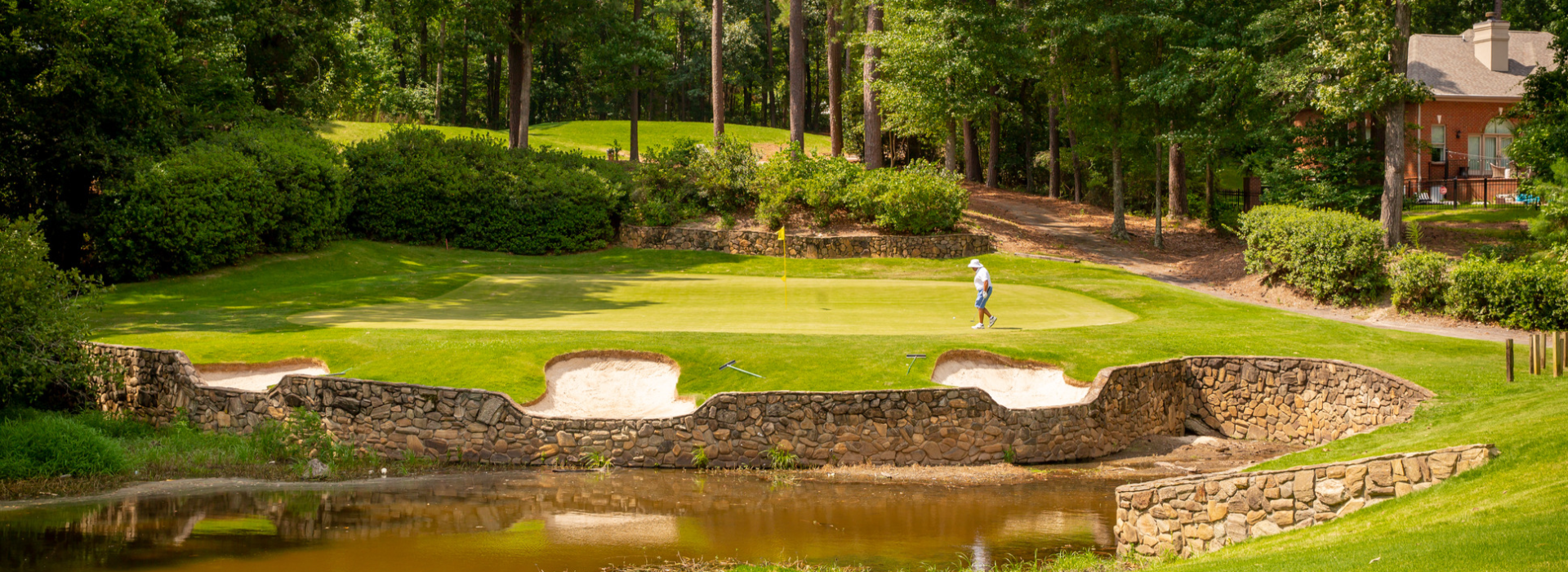In an effort to provide our members and guests with one of the best golf courses in the midlands of South Carolina, we will begin an extensive renovation project at the end of May 2015. The scope of work will include renovating the greens, rebuilding several tees, cart path repair and a few other key improvements. Our greens will be converted to Tifeagle bermudagrass and will require a six to eight week grown in period. While the greens are growing in we will rebuild the tee boxes on holes # 7 and # 13. The plan is to enlarge the tee areas and remove a few more trees to give more sunlight for better growth. We completed a substantial amount of cart path repair last year and our plan is to carry forward with the remaining areas in need of repair during the renovation period. The summer of 2015 will be very busy for the golf course but, once complete, the work will render much improved playing conditions and overall enjoyment of your experience at Golden Hills Golf and Country Club. Continue to re-visit our website throughout the days and weeks ahead, as we plan to provide updated information on the project and its progress.
The “Ground Work”
The experience only gets better at Golden Hills in 2015! We are excited about the renovation projects that will be taking place on the golf course this summer. While being the most extensive, this work will represent the final phase of our greens renovations. We anticipate a positive result that will enhance your enjoyment of the course for years to come.
The planning and preparation for this project has been years in the making. In 2012, we began serious discussion on the long range plan for greens that were pushing their 20+ year maturity. For years we have fought shade and circulation problems on the golf course, in an attempt to protect the natural beauty of the property. The green on hole # 17 had suffered for years due to its location and was a particular concern. Therefore, in July 2012, we decided to renovate the green and use it somewhat as a testing ground. The upper and lower tiers of the green were re-contoured in an effort to allow more pin placements and a better year round putting surface. Because of its shade tolerance, we decided to sod the newly contoured surface with Diamond Zoysia turf. We have been pleased with the results and the decision to use Diamond Zoysia on hole # 17.
In an attempt to choose the ultradwarf most suitable for the remaining greens at Golden Hills, we reached out to numerous professionals in the industry. Input was garnered from turf grass growers, professors, research universities, contractors and fellow golf course superintendents. In addition, we sought input from the golfer’s perspective. We spoke with golf professionals and traveled with fellow members to courses throughout the state to assess different turf complexes.
Nearing the midpoint of 2014, the decision was made to use TifEagle bermudagrass for the remaining greens renovation. TifEagle has a number of unique advantages over traditional bermudagrass greens varieties, as well as many of the new ultradwarf varieties. Traditional grasses have not held up to the physical stress produced by lower mowing heights and frequent verticuttings which are used to control thatch build-up. TifEagle can. It also recovers more quickly from mechanical injury, has better color, and is extremely cold-hardy, drought-tolerant and disease-resistant. All in all, we’ve found that TifEagle can produce a quality putting surface second to none.
After deciding on TifEagle, we choose to begin construction on a new tee and two greens complexes before the end of the 2014 growing season. The bunker in front of the green on hole # 5 was removed in order for the size of the green to almost be doubled. The approach to the green on hole # 14 received an entirely different look. New tees were added and a new greens complex was constructed to the left of the former green. The insight and experience we have gained through the construction, grown-in and maintenance of the two new greens complexes will prove beneficial to us as we approach the remaining renovations this summer. The two new greens are doing well and will continue to mature and flourish throughout this spring and summer growth season.
Preparations for the final phase of the renovation project have been ongoing for a while now. The first step in a renovation project is to identify existing situations or problems that lower the quality of greens or that create management challenges. Again, we have reached out to numerous professionals in the industry to assist us with this evaluation process for the greens, as well as for several tees. Some of the more visible conclusions we have reached that you will see prior to the work this summer is the removal of several trees, changes to irrigation and drainage work. These and other changes are being made to provide optimal growing conditions and to improve the quality of play on the golf course.
We are excited about the changes that are currently taking place at Golden Hills. Now that you know a little more about the background, you can see that we have put a lot of time, study and effort into this project. As we approach the work that will begin at the end of May, we will provide you with more information on the actual process that will take place and the next steps.
The Renovation Process
Golf course renovations can be a monumental undertaking for any golf club. Every renovation project is unique and demands creativity, flexibility and a substantial investment. It requires a well-orchestrated team of individuals including – but not limited to – the golf course superintendent, club manager, turf grass professionals and their respective staff members.
The green is the most important feature of a golf course, as such, more time is devoted to its renovation than any other. Renovating greens is a technical construction process and we have worked diligently in putting together the plan we intend to follow. The concept we will use for the greens renovation is called “no-till”. It basically involves verticutting, aerification and the application of either Roundup or fumigation to kill the existing grass. This is done to create a healthy seedbed for the distribution of fresh new TifEagle sprigs. Below is a more detailed breakdown of how we will incorporate this process:
- Verticut greens and collars to remove the thatch. Verticutting will be done multiple times in order to remove as much old matter as possible. A thorough clean-up of all debris will follow.
- Core aerify greens and collars. Remove cores and topdress with a 70/30 mix to fill core holes.
- Remove a 42” wide strip of sod (the collar) from the perimeter of the green so you can fumigate outside the wall of the green.
- After verticutting and aerification, it is recommended to use fumigation to kill the existing grass. Although its cost is much greater, we have chosen fumigation due to its results insuring genetic purity and uniform color in newly established turf. Tarps will be installed to cover each green, then a hot gas fumigate will be applied. The covers will be removed after 48 hours.
- Collars will be sodded with a 42” wide roll of TifGrand. We have chosen TifGrand because it is more shade tolerant and thicker. Once the collars are sodded, the greens will be planted with TifEagle sprigs. In order to insure freshness and timely irrigation, sprigs will be distributed on half the greens one day and on the remaining half the following day. Once the sprigs have been planted, they will be thoroughly rolled in and topdressed.
- Irrigate, fertilize and inspect. The sprigs need to be constantly moist until rooted. Once active growth starts, fertilizer will be applied weekly. Throughout the grow-in, the greens will be closely monitored and tested. Adjustments in irrigation and fertilization will be made as needed.
On May 26th, we will begin setting up the temporary greens and start the “no-till” process on the old greens. As time allows from the work on the greens, we will begin renovating several tees and repairing additional cart paths. The renovation project will be very labor intensive but we are fortunate to have a staff that is committed to the task and equally excited about the results to come.
The green and surrounding area on hole 9 suffered due to shade. Although it was tough to remove a long standing &…
Posted by Golden Hills Golf & Country Club



